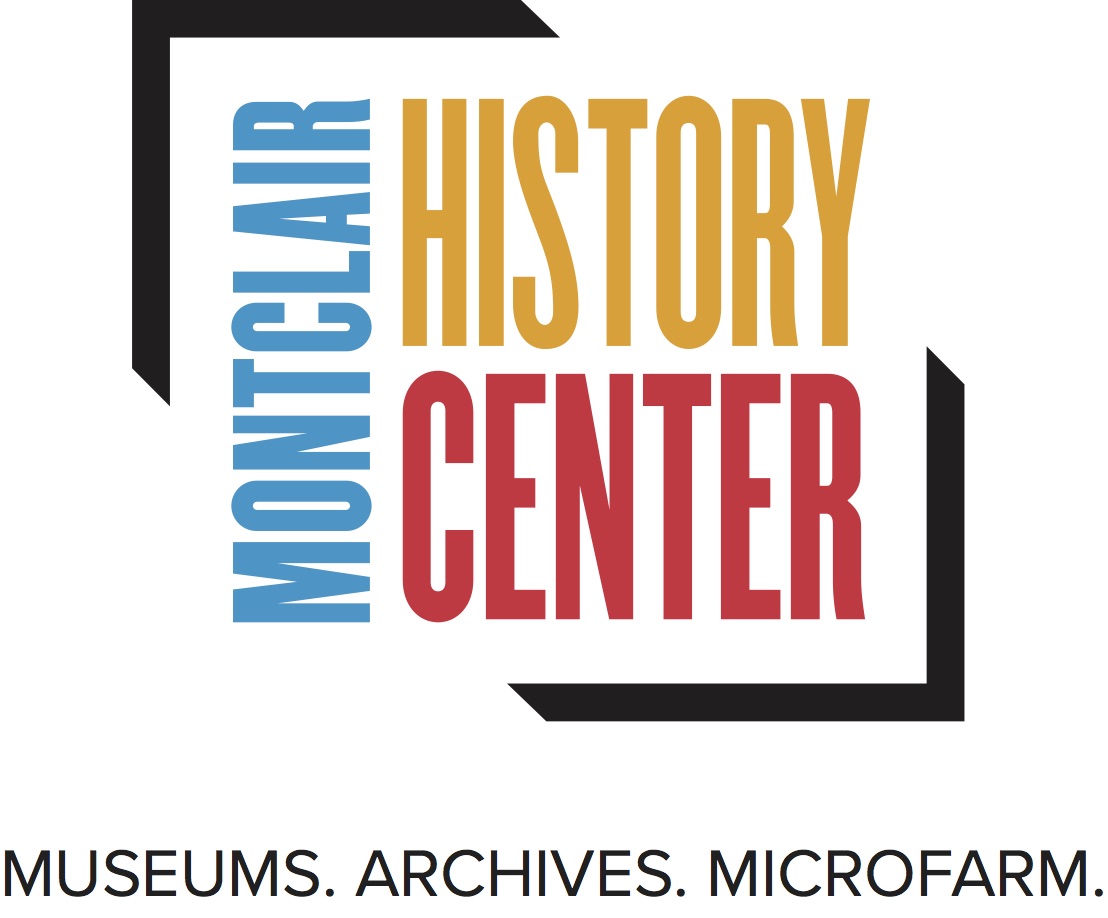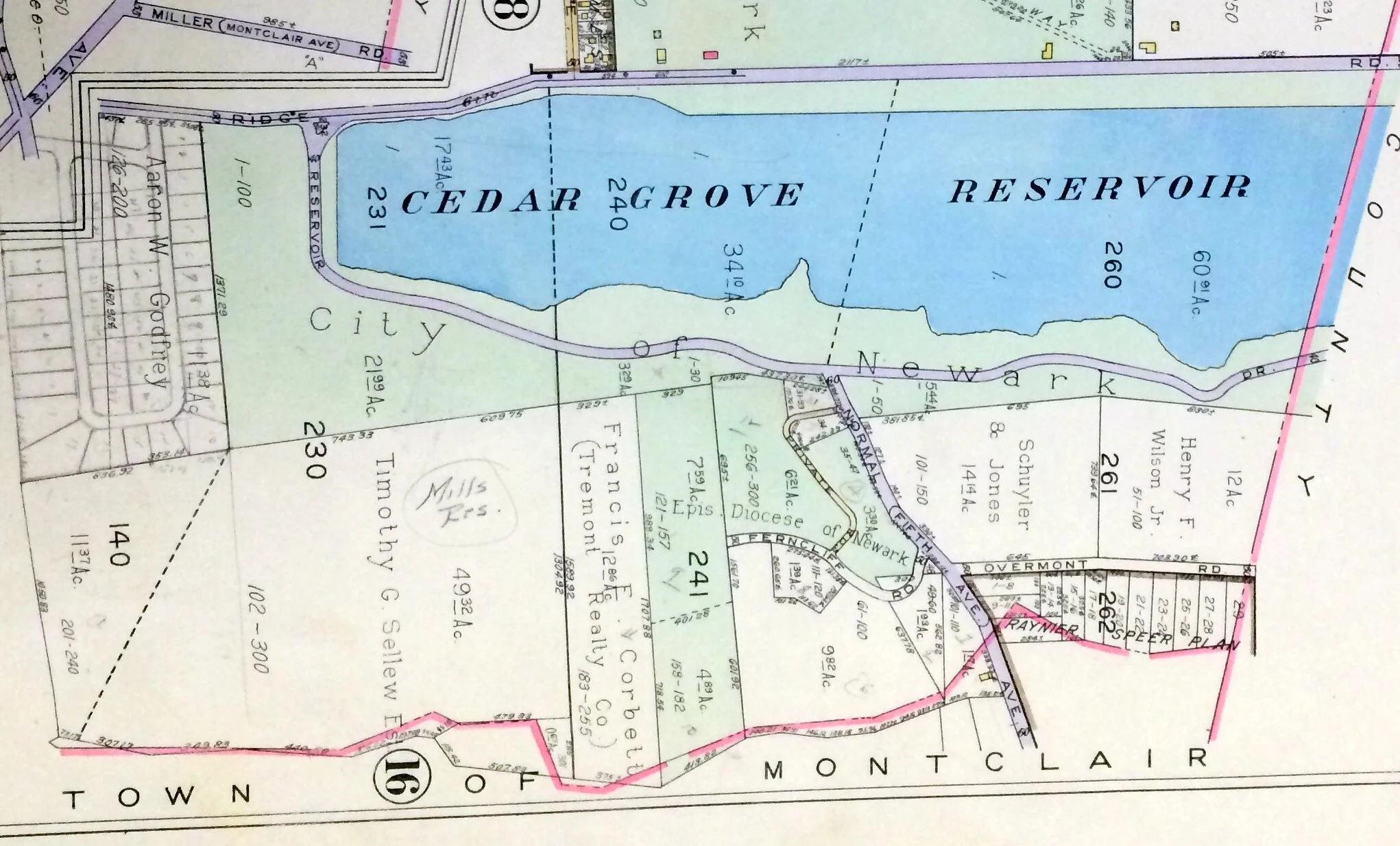Thanks for visiting our blog! While you're here, we invite you to explore our website, especially under the "Archives & Library" tab - we think you'll find a few more things that interest you. Add your name to our mailing list so you are notified when we Zoom weekly presentations on Thursdays at noon and 7 pm. Lastly, like so many other organizations, we'd also greatly appreciate your support at this time -- would you consider becoming a member, supporting one of our remaining fundraisers -- the Herb Sale (pre-orders ONLY this year), or purchasing a heritage brick or a personalized replica map? Thank you for your support and best wishes for good health!
Republished from: Montclair Neighbors. July 2019
Written by Helen Fallon, MHC Trustee
Detail of the 1933 Property Atlas of Montclair, published by Franklin Survey Co., showing land owned by the Episcopal Diocese of Newark from 1931-1952, in what is now Mills Reservation.
Many of us count our lucky stars that Mills Reservation — the wooded, Essex County-owned mountaintop park easily accessible to Montclair residents and just 12 miles west of one of the biggest cities in the world — was preserved for recreational use. Ever wonder how it came to be?
Mills Reservation began with a 118-acre donation from the Davella Mills Foundation to the Essex County Park Commission (ECPC) in 1954. Through additional land acquisitions in the 1960s, the reservation grew to the 157-acre Essex County Park we know today. It straddles the ridge between Montclair and Cedar Grove atop First Mountain, the easternmost of three ridges that comprise the Watchung Mountain chain. It runs from the Normal Avenue entrance in the north to the southern terminus on Old Quarry Road, accessible from Bradford Avenue.
By the early 17th century, English settlers, expanding west from their location in Newark, and Dutch settlers, moving beyond their lands in Bergen and Passaic counties, began to discover and settle lands along the slopes of First Mountain. Settlers in the vicinity of today’s Mills Reservation were primarily of Dutch descent. They had large farms, capitalizing on the streams and drainage afforded by the mountain slope. Maps from the early 1900s reveal plots owned by some of Upper Montclair’s and Cedar Grove’s founding Dutch farming families, including Speer (for whom Speertown, later Upper Montclair, was named), Jacobus, Van Reyper, and others.
A typical family drawn to Montclair for its easy commute: Mrs. Henry Moir and children at Upper Montclair Train Station, 1904. Photo courtesy Montclair Public Library Local History Collection.
The arrival of the trains that allowed easy, daily commuting from Montclair to Newark and New York City transformed the region.
Train service arrived to Grove and Elm streets in Montclair (then called West Bloomfield) in 1856. A second train line, with stations from Walnut Street to Normal Avenue (then called Fifth Avenue), began service in 1873; by this time the town had been renamed Montclair. The lure of an easy daily commute prompted many to build homes on the beautiful Montclair mountainside, prized for scenic views, fresh air, and a “healthful environment.” Train service spurred a building boom, with realtors referring to Montclair as “New York’s most charming suburb.” Montclair’s population exploded — growing from 5,100 residents in 1880 to 42,000 residents in 1930. Statisticians and planners predicted the population growth would continue.
Plaque on stone pillar in Mills Reservation, photo by Helen Fallon
In 1931, the Episcopal Diocese of Newark purchased nearly 40 acres of land in what is now Mills Reservation, planning to build a cathedral to serve the diocese’s increasingly suburban worshipers. Ultimately, they dedicated the existing, historic Trinity Church in Newark as their cathedral and sold their land holdings on the mountaintop to the Davella Mills Foundation in 1952.
Davella Mills acquired lots from multiple land owners in 1952 and donated 118 acres to the ECPC in 1954. The Olmsted Brothers Landscape Architects developed the park design seeking community input: should it be formally landscaped (such as the Olmsted-designed Brookdale and Anderson parks) or left as a natural woodland? Although the final design was indeed the naturalized setting we enjoy today, preliminary designs included a range of options that included camp and picnic sites, comfort stations, scenic overlooks, ball fields, playgrounds, stables, and multiple large parking areas to accommodate over 300 cars.
About the Mills
David and Ella Mills arrived in Montclair in the early 1900s. These philanthropists’ fortune grew when David invented a spark plug and sold it to General Motors. During their lifetimes, they donated funds to meet the building needs of several non-profits, religious, and educational institutions in Montclair and Cedar Grove. After Ella Mills died in 1931, half of the couple’s fortune was used to create the Davella Mills Foundation and the remainder was bequeathed to it upon David Mills’ death in 1944. By design, the fund was liquidated by 1955, having given away $10 million in 24 U.S. cities and 12 foreign countries.
David Mills. Photo courtesy of Montclair Public Library Local History Collection.




